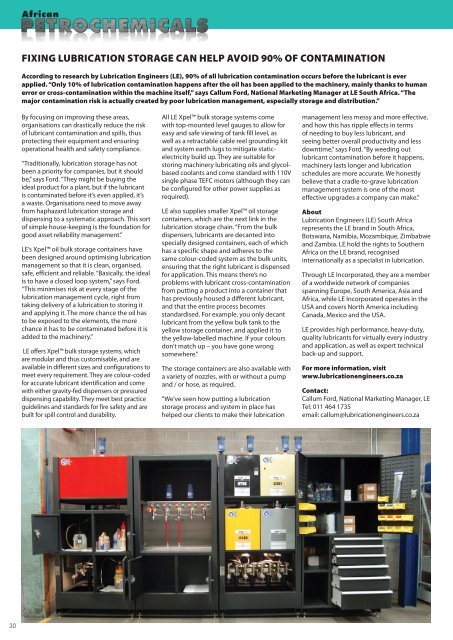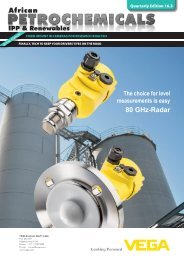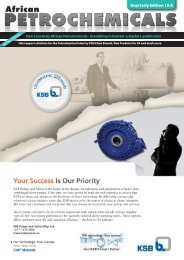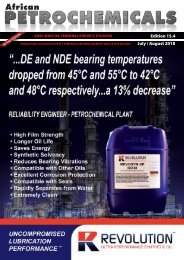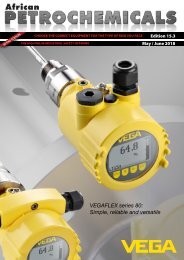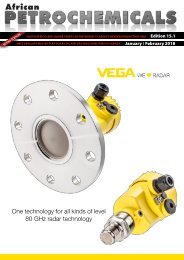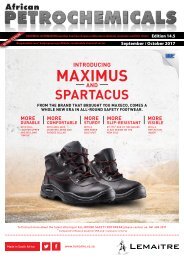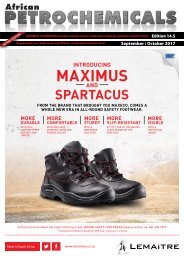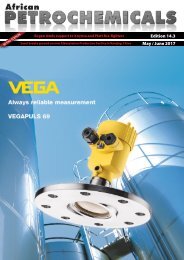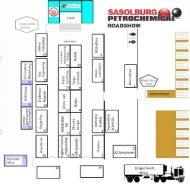African Petrochemicals Edition_16.2
You also want an ePaper? Increase the reach of your titles
YUMPU automatically turns print PDFs into web optimized ePapers that Google loves.
FIXING LUBRICATION STORAGE CAN HELP AVOID 90% OF CONTAMINATION<br />
According to research by Lubrication Engineers (LE), 90% of all lubrication contamination occurs before the lubricant is ever<br />
applied. “Only 10% of lubrication contamination happens after the oil has been applied to the machinery, mainly thanks to human<br />
error or cross-contamination within the machine itself,” says Callum Ford, National Marketing Manager at LE South Africa. “The<br />
major contamination risk is actually created by poor lubrication management, especially storage and distribution.”<br />
By focusing on improving these areas,<br />
organisations can drastically reduce the risk<br />
of lubricant contamination and spills, thus<br />
protecting their equipment and ensuring<br />
operational health and safety compliance.<br />
“Traditionally, lubrication storage has not<br />
been a priority for companies, but it should<br />
be,” says Ford. “They might be buying the<br />
ideal product for a plant, but if the lubricant<br />
is contaminated before it’s even applied, it’s<br />
a waste. Organisations need to move away<br />
from haphazard lubrication storage and<br />
dispensing to a systematic approach. This sort<br />
of simple house-keeping is the foundation for<br />
good asset reliability management.”<br />
LE’s Xpel oil bulk storage containers have<br />
been designed around optimising lubrication<br />
management so that it is clean, organised,<br />
safe, efficient and reliable. “Basically, the ideal<br />
is to have a closed loop system,” says Ford.<br />
“This minimises risk at every stage of the<br />
lubrication management cycle, right from<br />
taking delivery of a lubrication to storing it<br />
and applying it. The more chance the oil has<br />
to be exposed to the elements, the more<br />
chance it has to be contaminated before it is<br />
added to the machinery.”<br />
LE offers Xpel bulk storage systems, which<br />
are modular and thus customisable, and are<br />
available in different sizes and configurations to<br />
meet every requirement. They are colour-coded<br />
for accurate lubricant identification and come<br />
with either gravity-fed dispensers or pressured<br />
dispensing capability. They meet best practice<br />
guidelines and standards for fire safety and are<br />
built for spill control and durability.<br />
All LE Xpel bulk storage systems come<br />
with top-mounted level gauges to allow for<br />
easy and safe viewing of tank fill level, as<br />
well as a retractable cable reel grounding kit<br />
and system earth lugs to mitigate staticelectricity<br />
build up. They are suitable for<br />
storing machinery lubricating oils and glycolbased<br />
coolants and come standard with 110V<br />
single phase TEFC motors (although they can<br />
be configured for other power supplies as<br />
required).<br />
LE also supplies smaller Xpel oil storage<br />
containers, which are the next link in the<br />
lubrication storage chain. “From the bulk<br />
dispensers, lubricants are decanted into<br />
specially designed containers, each of which<br />
has a specific shape and adheres to the<br />
same colour-coded system as the bulk units,<br />
ensuring that the right lubricant is dispensed<br />
for application. This means there’s no<br />
problems with lubricant cross-contamination<br />
from putting a product into a container that<br />
has previously housed a different lubricant,<br />
and that the entire process becomes<br />
standardised. For example, you only decant<br />
lubricant from the yellow bulk tank to the<br />
yellow storage container, and applied it to<br />
the yellow-labelled machine. If your colours<br />
don’t match up – you have gone wrong<br />
somewhere.”<br />
The storage containers are also available with<br />
a variety of nozzles, with or without a pump<br />
and / or hose, as required.<br />
“We’ve seen how putting a lubrication<br />
storage process and system in place has<br />
helped our clients to make their lubrication<br />
management less messy and more effective,<br />
and how this has ripple effects in terms<br />
of needing to buy less lubricant, and<br />
seeing better overall productivity and less<br />
downtime,” says Ford. “By weeding out<br />
lubricant contamination before it happens,<br />
machinery lasts longer and lubrication<br />
schedules are more accurate. We honestly<br />
believe that a cradle-to-grave lubrication<br />
management system is one of the most<br />
effective upgrades a company can make.”<br />
About<br />
Lubrication Engineers (LE) South Africa<br />
represents the LE brand in South Africa,<br />
Botswana, Namibia, Mozambique, Zimbabwe<br />
and Zambia. LE hold the rights to Southern<br />
Africa on the LE brand, recognised<br />
internationally as a specialist in lubrication.<br />
Through LE Incorporated, they are a member<br />
of a worldwide network of companies<br />
spanning Europe, South America, Asia and<br />
Africa, while LE Incorporated operates in the<br />
USA and covers North America including<br />
Canada, Mexico and the USA.<br />
LE provides high performance, heavy-duty,<br />
quality lubricants for virtually every industry<br />
and application, as well as expert technical<br />
back-up and support.<br />
For more information, visit<br />
www.lubricationengineers.co.za<br />
Contact:<br />
Callum Ford, National Marketing Manager, LE<br />
Tel: 011 464 1735<br />
email: callum@lubricationengineers.co.za<br />
30


